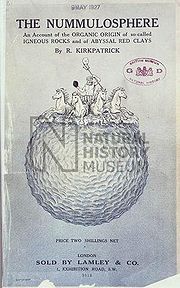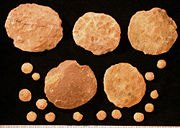
Randolph Kirkpatrick
Encyclopedia


United Kingdom
The United Kingdom of Great Britain and Northern IrelandIn the United Kingdom and Dependencies, other languages have been officially recognised as legitimate autochthonous languages under the European Charter for Regional or Minority Languages...
spongiologist, cnidariologist
Cnidariologist
-Examples:* Browne, Edward Thomas * Bigelow, Henry Bryant * Kirkpatrick, Randolph * Kishinouye, Kamakichi * Lassenius Kramp, Paul Torben * Mayer, Alfred G....
and bryozoologist. He was assistant keeper of lower invertebrates at the British Natural History Museum
Natural History Museum
The Natural History Museum is one of three large museums on Exhibition Road, South Kensington, London, England . Its main frontage is on Cromwell Road...
from 1886 until his retirement in 1927.
Kirkpatrick published a limited number of papers on the sponges
Sea sponge
Sponges are animals of the phylum Porifera . Their bodies consist of jelly-like mesohyl sandwiched between two thin layers of cells. While all animals have unspecialized cells that can transform into specialized cells, sponges are unique in having some specialized cells, but can also have...
of Antarctica and the Indian Ocean
Indian Ocean
The Indian Ocean is the third largest of the world's oceanic divisions, covering approximately 20% of the water on the Earth's surface. It is bounded on the north by the Indian Subcontinent and Arabian Peninsula ; on the west by eastern Africa; on the east by Indochina, the Sunda Islands, and...
. However, his most significant work was carried out on Merlia, a species of coralline sponge
Sclerosponge
|frame|Ceratoporella nicholsoni, cut specimen from [[Pedro Bank]], [[Caribbean Sea]], about 15 cm wide. Brown sponge tissue covers white massive [[aragonite]] [[skeleton]]....
(a sponge which secretes a coral-like limestone
Limestone
Limestone is a sedimentary rock composed largely of the minerals calcite and aragonite, which are different crystal forms of calcium carbonate . Many limestones are composed from skeletal fragments of marine organisms such as coral or foraminifera....
skeleton
Skeleton
The skeleton is the body part that forms the supporting structure of an organism. There are two different skeletal types: the exoskeleton, which is the stable outer shell of an organism, and the endoskeleton, which forms the support structure inside the body.In a figurative sense, skeleton can...
). He was the first to correctly interpret these unusual sponges, but his work was largely ignored until the 1960s when W. D. Hartman and T. F. Goreau rediscovered the coralline sponges.
It is possible that his important work on the coralline sponges was dismissed by his contemporaries due to his having published a book containing unconventional ideas about the history of life on earth. This was the self-published The Nummulosphere: an account of the Organic Origin of so-called Igneous Rocks and Abyssal Red Clays (1912), printed by Lamley & Co. of South Kensington. His book proposed the unusual theory that all rocks had been formed by the accumulation of forams such as nummulite
Nummulite
thumb|left|250px|Fossil Nummulites in [[Urbasa]], [[Basque Country |Basque Country]]A nummulite is a large lenticular fossil, characterized by its numerous coils, subdivided by septa into chambers. They are the shells of the fossil and present-day marine protozoan Nummulites, a type of foraminiferan...
s.
Kirkpatrick also identified and named the mollusc Pickworthia kirkpatricki Iredale, 1917 (now in the genus
Genus
In biology, a genus is a low-level taxonomic rank used in the biological classification of living and fossil organisms, which is an example of definition by genus and differentia...
Sansonia Jousseaume, 1892).

